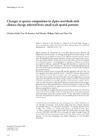Changes in species composition in alpine snowbeds with climate change inferred from small-scale spatial patterns

Open access
Date
2008Type
- Journal Article
ETH Bibliography
no
Altmetrics
Abstract
Alpine snowbeds are characterised by a very short growing season. However, the length of the snow-free period is increasingly prolonged due to climate change, so that snowbeds become susceptible to invasions from neighbouring alpine meadow communities. We hypothesised that spatial distribution of species generated by plant interactions may indicate whether snowbed species will coexist with or will be out-competed by invading alpine species – spatial aggregation or segregation will point to coexistence or competitive exclusion, respectively. We tested this hypothesis in snowbeds of the Swiss Alps using the variance ratio statistics. We focused on the relationships between dominant snowbed species, subordinate snowbed species, and potentially invading alpine grassland species. Subordinate snowbed species were generally spatially aggregated with each other, but were segregated from alpine grassland species.
Competition between alpine grassland and subordinate snowbed species may have caused this segregation. Segregation between these species groups increased with earlier snowmelt, suggesting an increasing importance of competition with climate change. Further, a dominant snowbed species (Alchemilla pentaphyllea) was spatially aggregated with subordinate snowbed species, while two other dominants (Gnaphalium supinum and Salix herbacea) showed aggregated patterns with alpine grassland species. These dominant species are known to show distinct microhabitat preferences suggesting the existence of hidden microhabitats with different susceptibility to invaders.
These results allow us to suggest that alpine snowbed areas are likely to be reduced as a consequence of climate change and that invading species from nearby alpine grasslands could outcompete subordinate snowbed species. On the other hand, microhabitats dominated by Gnaphalium or Salix seem to be particularly prone to invasions by non-snowbed species. Show more
Permanent link
https://doi.org/10.3929/ethz-b-000222357Publication status
publishedExternal links
Journal / series
Web EcologyVolume
Pages / Article No.
Publisher
CopernicusOrganisational unit
02350 - Dep. Umweltsystemwissenschaften / Dep. of Environmental Systems Science00012 - Lehre und Forschung
02703 - Institut für Agrarwissenschaften / Institute of Agricultural Sciences
09618 - Schöb, Christian (ehemalig) / Schöb, Christian (former)
More
Show all metadata
ETH Bibliography
no
Altmetrics


